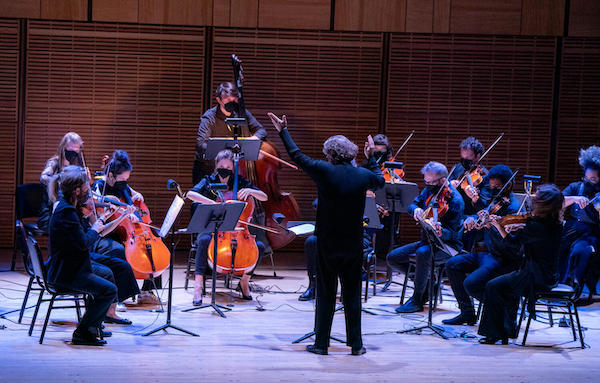Ensemble Signal marks the century with timeless Gordon and Wolfe works

New musical ideas come along less frequently than old ones are revived, repackaged, and refracted through new methods and technologies. This is not to denigrate contemporary music, but to place it in the context it deserves, which is with the great eras and works of the past.
That was the feeling in Zankel Hall Wednesday night, where Ensemble Signal played music by Michael Gordon and Julia Wolfe.
The composers are two of the most important from the post-minimalism period. Hearing their pieces Weather One and Cruel Sister played with such vitality could not have been far from a concert at the Esterházy court—great music played by experienced collaborators.
Another notable thing about this concert was that there was nothing brand new on the program. With Tessa Lark playing Wolfe’s solo violin piece, With a blue dress on, this was all repertoire music, everything composed more than a decade ago. That this unremarkable feature showed up on an all-contemporary music program, was, well, remarkable. Like it was 250 years ago, all of the music was both to the times and part of history.
The physicality and vibrancy of the pieces and performers cannot be overstated. Both Gordon and Wolfe make gripping experiences out of the basic elements of classical structures and forms, with counterpoint, polyphony, and superb voice leading. The two have a natural affinity toward expressive intensity through a language that is forceful and objective. The expressive goal might be different—for Gordon, a sonic representation, high abstracted and formal, of changing weather (a loose response to Vivaldi), and for Wolfe, narratives, also abstracted, with roots in both folk tales and folk music.
The altitude and sonic imprint of this music are shaped by society and culture of this era. Most immediate was the use of amplification and sound reinforcement, managed by Paul Coleman. This gave the strings a glass-edged, metallic timbre that was invigorating. More personally expressive, but very much of the moment, was the clear-eyed and almost obsessive focus of the music, the consistent manner of working away at small details until they expanded into large and powerful forms. Those accumulated into syncopations, cross rhythms, harmonic movement, and formal designs that were exciting and satisfying in themselves and an affirmation of the relevance of this art in the 21st century.
All these pieces are so finely made that the performance was less a matter of the musicians injecting power into the notes but rather what was on the page driving the playing. There were moments in Weather One and Cruel Sister where the ensemble seemed at the edge of possibilities, the players nearly springing forward from their positions. One admired both the energy and unerring pose from conductor Brad Lubman, one of the centers of excellence in this group. The ensemble pieces especially were thrilling, the music bursting with the expressive power and social force of the most compelling rock bands.
In between was With a blue dress on, based on a field recording Wolfe heard of a woman singing a folk song. The piece has the violinist singing while playing, and combines the live playing with looping and prerecorded tracks. Lark gave it a skillful and haunting performance, but the interiority of the music, touching on a palpable darkness, was perhaps too unsettling after the tremendous storm of Weather One. Gordon’s piece balances disturbance with structure, it works from the inside out, while the variations in the solo music were directed further and further inward.
But that experience was a matter of personal taste. Cruel Sister takes a folk music narrative but eschews the music, and the lyrics, for a totally original work that Wolfe noted was her own return to narrative forms. The shape of the piece and the way it builds are both subtle and enthralling, as was the performance, which drew one in with a slight diffidence before laying down a hammer of intensity.
In another, and highly effective, feature of 21st century possibilities, the rising, climactic finale was accompanied by gradually brightening floodlights at the back of the stage, the shadows throwing a pantomime that added intrigue, tension, and even beauty to this vibrant evening.
The Kronos Quartet plays George Crumb’s Black Angels and other works, 9 p.m., April 23 carnegiehall.org







